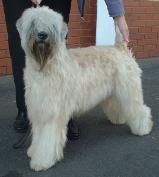
This is a placeholder text
Group text
by Abhay on 06 February 2009 - 00:02
Wolf In Dog's Clothing? Black Wolves May Be First 'Genetically Modified' Predators
ScienceDaily (Feb. 5, 2009) — Slipping through trees or across snow, the wolf has glided into legend on paws of white, gray or — in North America — even black. This last group owes an unexpected debt to the cousins of the domestic dog, say Stanford researchers. In an unconventional evolutionary twist, dogs that bred with wolves thousands of years ago ceded a genetic mutation encoding dark coat color to their former ancestors. As a result, the Gray Wolf, or Canis lupus, is no longer just gray.
The effect was more than just cosmetic: the resulting black wolves, which are found nearly exclusively in North America, seem to have a selective advantage over lighter-colored wolves in forested areas. It's a rare instance of domestic animals — in this case, probably the dogs of the earliest Native Americans — contributing to the genetic variability of their wild counterparts in a way that affects both the recipients' appearance and survival.
"We usually think of domestication as something that is carried out to benefit humans," said genetics professor Greg Barsh, MD, PhD. "So we were really surprised to find that domestic animals can serve as a genetic reservoir that can benefit the natural populations from which they were derived. It's also fascinating to think that a portion of the first Native American dogs, which are now extinct, may live on in wolves." Canine geneticists generally agree that North American dogs today are all descended from European dogs.
Barsh and graduate student Tovi Anderson collaborated with, among others, scientists at the University of California-Los Angeles, the University of Calgary, the National Park Service at Yellowstone National Park and the National Human Genome Research Institute to conduct the research. Scientists from Sweden and Italy also participated in the international effort.
Anderson and her collaborators compared DNA collected from 41 black, white and gray wolves in the Canadian Arctic and 224 black and gray wolves in Yellowstone National Park with that of domestic dogs and gray and black coyotes. Their intention was to build on previous work in the Barsh lab that identified a mechanism controlling pigmentation in dogs that differs from most other mammals.
"We expected this to be a short research project to confirm that wolves and dogs shared the same genetic pathway that determines black coat color," said Anderson. "But the story got much more interesting when we expanded our research and began asking about the origin of the mutation in wolves."
Dark-coated wolves are significantly more prevalent in forested areas of the Canadian Arctic than they are in the icy tundra (62% vs. 7% of the total population, respectively). Biologists have long suspected that something about having black fur is particularly advantageous for the woodland wolves, but they weren't sure what. Because black wolves gray with age, it seems that the root cause might be deeper than just coat color.
Barsh's laboratory, which has spent years studying genes affecting coat color and other biological pathways in mammals, discovered in 2007 that the gene responsible for black fur in dogs, called beta-defensin, belongs to a family of genes previously believed to be involved in fighting infection. One version of the gene produces light or yellow-colored dogs and wolves; a mutant version missing three nucleotides produces black animals.
"Wildlife biologists don't really think that wolves rely much on camouflage to protect themselves or to increase their hunting success," said
by yellowrose of Texas on 06 February 2009 - 01:02
yr
by Abhay on 06 February 2009 - 01:02
by yellowrose of Texas on 06 February 2009 - 01:02
by pod on 06 February 2009 - 08:02
by Kaffirdog on 06 February 2009 - 09:02
Margaret N-J
by AnjaBlue on 06 February 2009 - 13:02
Contact information Disclaimer Privacy Statement Copyright Information Terms of Service Cookie policy ↑ Back to top




